Challenges in HRM: Strategies for Multinational Corporations
VerifiedAdded on 2023/01/18
|9
|2712
|53
Report
AI Summary
This report examines the human resource management (HRM) challenges encountered by multinational organizations operating in a global landscape. It identifies and evaluates key challenges, including recruitment, selection, and retention of employees; benefits and compensation complexities; HR planning difficulties; and the acceptance of management changes. The report delves into the intricacies of these challenges, highlighting issues such as the need to attract and retain skilled employees in a competitive market, the impact of changing global compensation policies, and the importance of effective HR planning in adapting to innovation and environmental issues. Moreover, the report emphasizes the significance of addressing employee resistance to change. For each challenge, the report provides recommendations, such as emphasizing employee motivation, tailoring compensation plans to local contexts, implementing fixed policies, and fostering effective communication and training. The report concludes by underscoring the importance of proactive HRM strategies to navigate these complexities and achieve organizational success in a global environment.
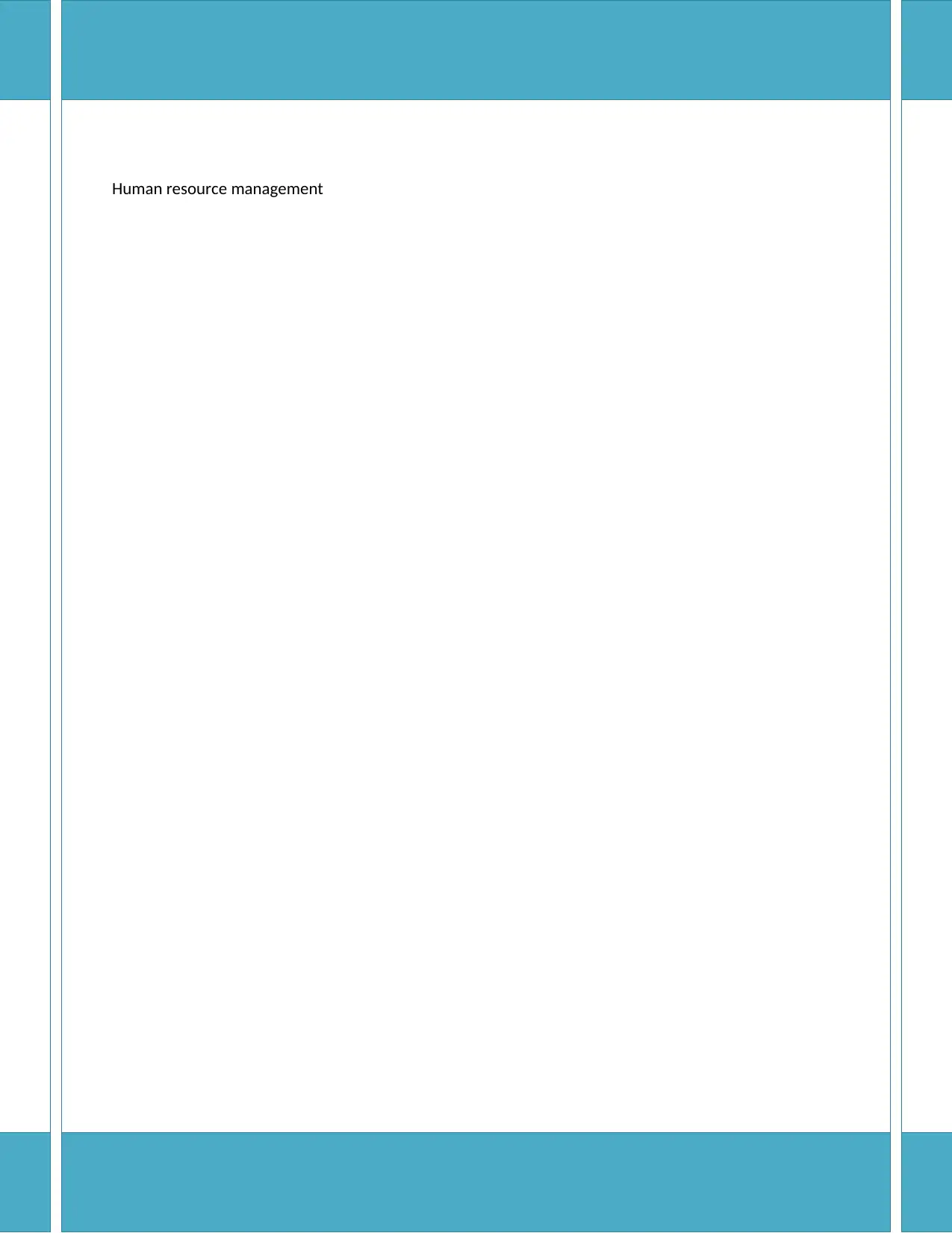
Human resource management
Paraphrase This Document
Need a fresh take? Get an instant paraphrase of this document with our AI Paraphraser
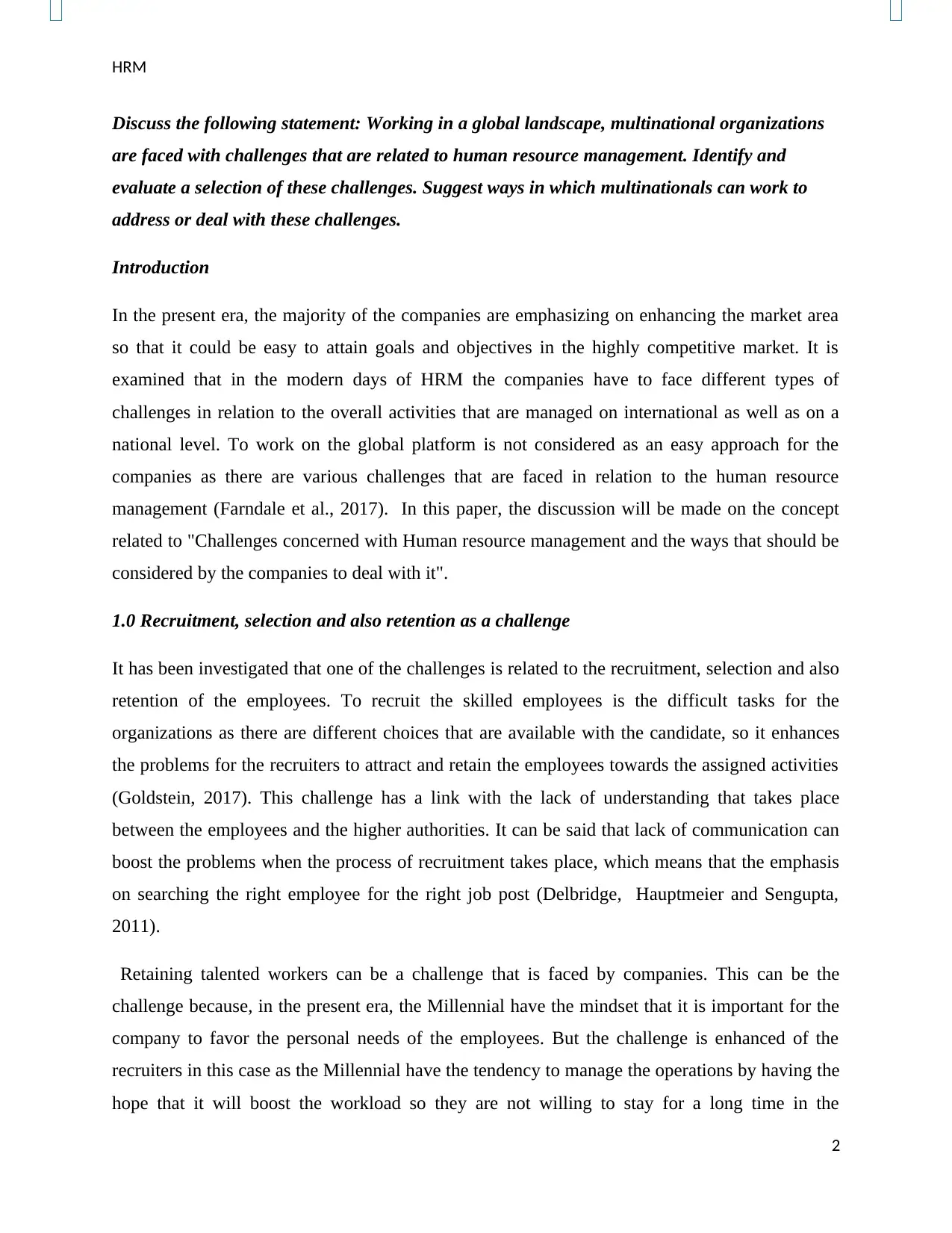
HRM
Discuss the following statement: Working in a global landscape, multinational organizations
are faced with challenges that are related to human resource management. Identify and
evaluate a selection of these challenges. Suggest ways in which multinationals can work to
address or deal with these challenges.
Introduction
In the present era, the majority of the companies are emphasizing on enhancing the market area
so that it could be easy to attain goals and objectives in the highly competitive market. It is
examined that in the modern days of HRM the companies have to face different types of
challenges in relation to the overall activities that are managed on international as well as on a
national level. To work on the global platform is not considered as an easy approach for the
companies as there are various challenges that are faced in relation to the human resource
management (Farndale et al., 2017). In this paper, the discussion will be made on the concept
related to "Challenges concerned with Human resource management and the ways that should be
considered by the companies to deal with it".
1.0 Recruitment, selection and also retention as a challenge
It has been investigated that one of the challenges is related to the recruitment, selection and also
retention of the employees. To recruit the skilled employees is the difficult tasks for the
organizations as there are different choices that are available with the candidate, so it enhances
the problems for the recruiters to attract and retain the employees towards the assigned activities
(Goldstein, 2017). This challenge has a link with the lack of understanding that takes place
between the employees and the higher authorities. It can be said that lack of communication can
boost the problems when the process of recruitment takes place, which means that the emphasis
on searching the right employee for the right job post (Delbridge, Hauptmeier and Sengupta,
2011).
Retaining talented workers can be a challenge that is faced by companies. This can be the
challenge because, in the present era, the Millennial have the mindset that it is important for the
company to favor the personal needs of the employees. But the challenge is enhanced of the
recruiters in this case as the Millennial have the tendency to manage the operations by having the
hope that it will boost the workload so they are not willing to stay for a long time in the
2
Discuss the following statement: Working in a global landscape, multinational organizations
are faced with challenges that are related to human resource management. Identify and
evaluate a selection of these challenges. Suggest ways in which multinationals can work to
address or deal with these challenges.
Introduction
In the present era, the majority of the companies are emphasizing on enhancing the market area
so that it could be easy to attain goals and objectives in the highly competitive market. It is
examined that in the modern days of HRM the companies have to face different types of
challenges in relation to the overall activities that are managed on international as well as on a
national level. To work on the global platform is not considered as an easy approach for the
companies as there are various challenges that are faced in relation to the human resource
management (Farndale et al., 2017). In this paper, the discussion will be made on the concept
related to "Challenges concerned with Human resource management and the ways that should be
considered by the companies to deal with it".
1.0 Recruitment, selection and also retention as a challenge
It has been investigated that one of the challenges is related to the recruitment, selection and also
retention of the employees. To recruit the skilled employees is the difficult tasks for the
organizations as there are different choices that are available with the candidate, so it enhances
the problems for the recruiters to attract and retain the employees towards the assigned activities
(Goldstein, 2017). This challenge has a link with the lack of understanding that takes place
between the employees and the higher authorities. It can be said that lack of communication can
boost the problems when the process of recruitment takes place, which means that the emphasis
on searching the right employee for the right job post (Delbridge, Hauptmeier and Sengupta,
2011).
Retaining talented workers can be a challenge that is faced by companies. This can be the
challenge because, in the present era, the Millennial have the mindset that it is important for the
company to favor the personal needs of the employees. But the challenge is enhanced of the
recruiters in this case as the Millennial have the tendency to manage the operations by having the
hope that it will boost the workload so they are not willing to stay for a long time in the
2
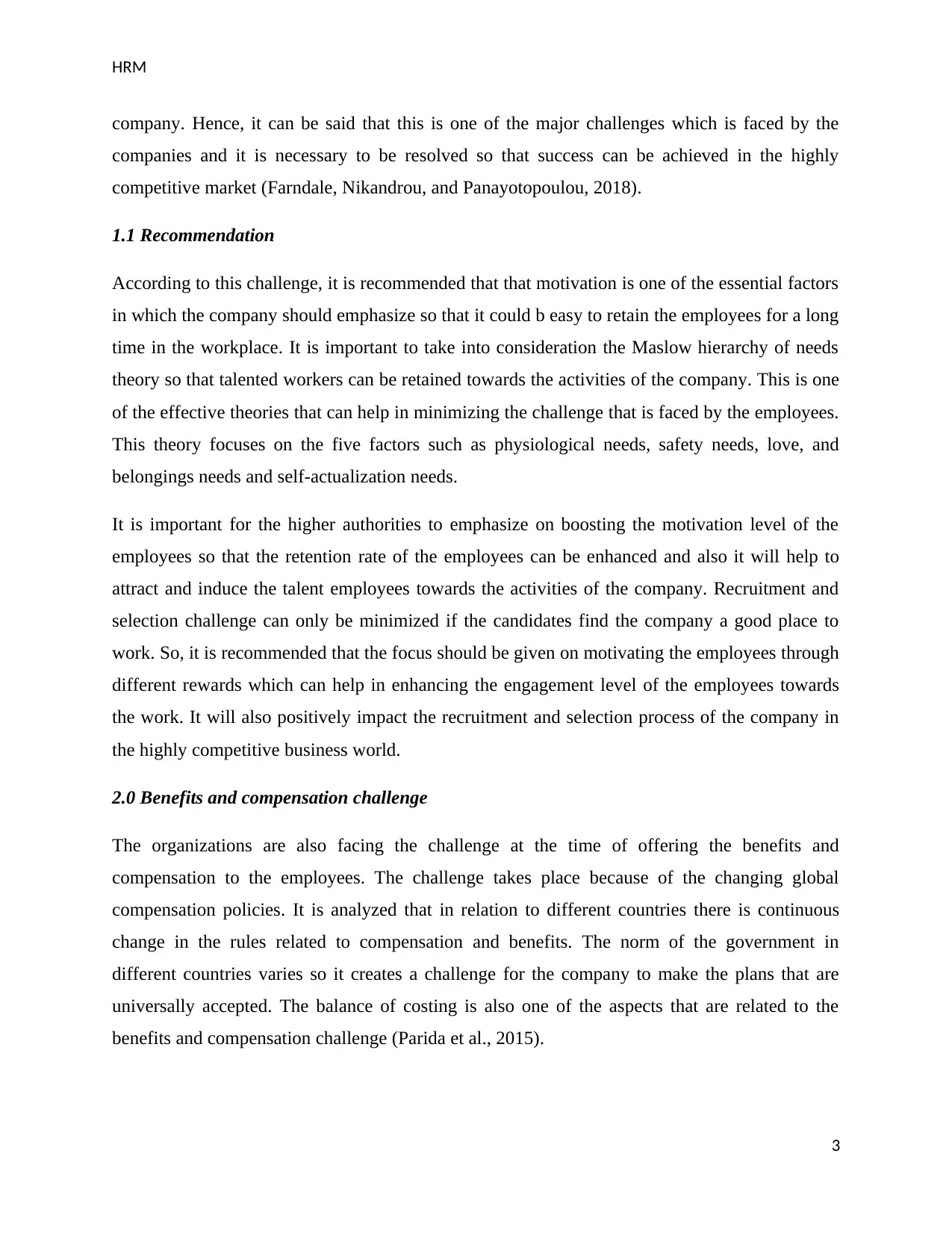
HRM
company. Hence, it can be said that this is one of the major challenges which is faced by the
companies and it is necessary to be resolved so that success can be achieved in the highly
competitive market (Farndale, Nikandrou, and Panayotopoulou, 2018).
1.1 Recommendation
According to this challenge, it is recommended that that motivation is one of the essential factors
in which the company should emphasize so that it could b easy to retain the employees for a long
time in the workplace. It is important to take into consideration the Maslow hierarchy of needs
theory so that talented workers can be retained towards the activities of the company. This is one
of the effective theories that can help in minimizing the challenge that is faced by the employees.
This theory focuses on the five factors such as physiological needs, safety needs, love, and
belongings needs and self-actualization needs.
It is important for the higher authorities to emphasize on boosting the motivation level of the
employees so that the retention rate of the employees can be enhanced and also it will help to
attract and induce the talent employees towards the activities of the company. Recruitment and
selection challenge can only be minimized if the candidates find the company a good place to
work. So, it is recommended that the focus should be given on motivating the employees through
different rewards which can help in enhancing the engagement level of the employees towards
the work. It will also positively impact the recruitment and selection process of the company in
the highly competitive business world.
2.0 Benefits and compensation challenge
The organizations are also facing the challenge at the time of offering the benefits and
compensation to the employees. The challenge takes place because of the changing global
compensation policies. It is analyzed that in relation to different countries there is continuous
change in the rules related to compensation and benefits. The norm of the government in
different countries varies so it creates a challenge for the company to make the plans that are
universally accepted. The balance of costing is also one of the aspects that are related to the
benefits and compensation challenge (Parida et al., 2015).
3
company. Hence, it can be said that this is one of the major challenges which is faced by the
companies and it is necessary to be resolved so that success can be achieved in the highly
competitive market (Farndale, Nikandrou, and Panayotopoulou, 2018).
1.1 Recommendation
According to this challenge, it is recommended that that motivation is one of the essential factors
in which the company should emphasize so that it could b easy to retain the employees for a long
time in the workplace. It is important to take into consideration the Maslow hierarchy of needs
theory so that talented workers can be retained towards the activities of the company. This is one
of the effective theories that can help in minimizing the challenge that is faced by the employees.
This theory focuses on the five factors such as physiological needs, safety needs, love, and
belongings needs and self-actualization needs.
It is important for the higher authorities to emphasize on boosting the motivation level of the
employees so that the retention rate of the employees can be enhanced and also it will help to
attract and induce the talent employees towards the activities of the company. Recruitment and
selection challenge can only be minimized if the candidates find the company a good place to
work. So, it is recommended that the focus should be given on motivating the employees through
different rewards which can help in enhancing the engagement level of the employees towards
the work. It will also positively impact the recruitment and selection process of the company in
the highly competitive business world.
2.0 Benefits and compensation challenge
The organizations are also facing the challenge at the time of offering the benefits and
compensation to the employees. The challenge takes place because of the changing global
compensation policies. It is analyzed that in relation to different countries there is continuous
change in the rules related to compensation and benefits. The norm of the government in
different countries varies so it creates a challenge for the company to make the plans that are
universally accepted. The balance of costing is also one of the aspects that are related to the
benefits and compensation challenge (Parida et al., 2015).
3
⊘ This is a preview!⊘
Do you want full access?
Subscribe today to unlock all pages.

Trusted by 1+ million students worldwide
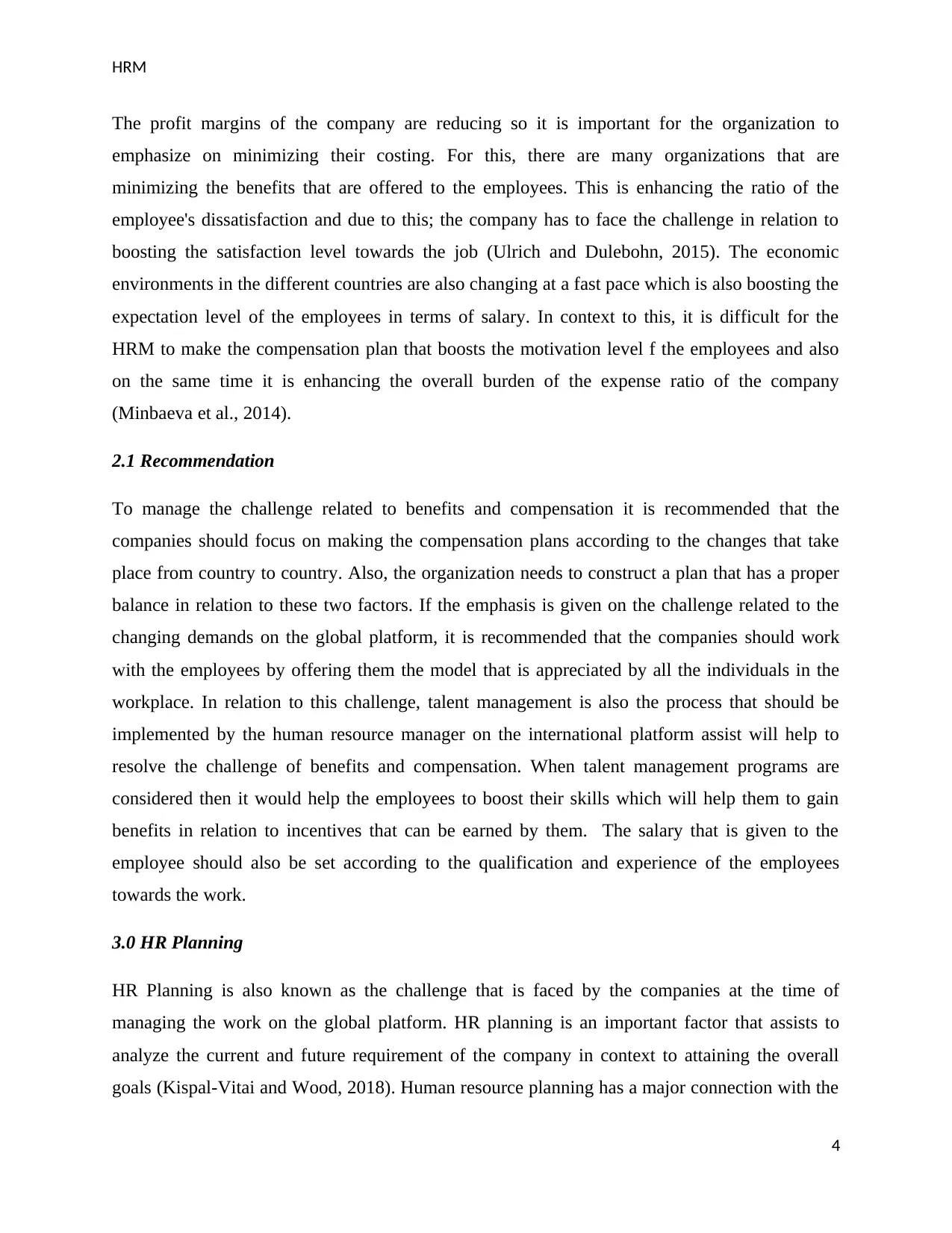
HRM
The profit margins of the company are reducing so it is important for the organization to
emphasize on minimizing their costing. For this, there are many organizations that are
minimizing the benefits that are offered to the employees. This is enhancing the ratio of the
employee's dissatisfaction and due to this; the company has to face the challenge in relation to
boosting the satisfaction level towards the job (Ulrich and Dulebohn, 2015). The economic
environments in the different countries are also changing at a fast pace which is also boosting the
expectation level of the employees in terms of salary. In context to this, it is difficult for the
HRM to make the compensation plan that boosts the motivation level f the employees and also
on the same time it is enhancing the overall burden of the expense ratio of the company
(Minbaeva et al., 2014).
2.1 Recommendation
To manage the challenge related to benefits and compensation it is recommended that the
companies should focus on making the compensation plans according to the changes that take
place from country to country. Also, the organization needs to construct a plan that has a proper
balance in relation to these two factors. If the emphasis is given on the challenge related to the
changing demands on the global platform, it is recommended that the companies should work
with the employees by offering them the model that is appreciated by all the individuals in the
workplace. In relation to this challenge, talent management is also the process that should be
implemented by the human resource manager on the international platform assist will help to
resolve the challenge of benefits and compensation. When talent management programs are
considered then it would help the employees to boost their skills which will help them to gain
benefits in relation to incentives that can be earned by them. The salary that is given to the
employee should also be set according to the qualification and experience of the employees
towards the work.
3.0 HR Planning
HR Planning is also known as the challenge that is faced by the companies at the time of
managing the work on the global platform. HR planning is an important factor that assists to
analyze the current and future requirement of the company in context to attaining the overall
goals (Kispal-Vitai and Wood, 2018). Human resource planning has a major connection with the
4
The profit margins of the company are reducing so it is important for the organization to
emphasize on minimizing their costing. For this, there are many organizations that are
minimizing the benefits that are offered to the employees. This is enhancing the ratio of the
employee's dissatisfaction and due to this; the company has to face the challenge in relation to
boosting the satisfaction level towards the job (Ulrich and Dulebohn, 2015). The economic
environments in the different countries are also changing at a fast pace which is also boosting the
expectation level of the employees in terms of salary. In context to this, it is difficult for the
HRM to make the compensation plan that boosts the motivation level f the employees and also
on the same time it is enhancing the overall burden of the expense ratio of the company
(Minbaeva et al., 2014).
2.1 Recommendation
To manage the challenge related to benefits and compensation it is recommended that the
companies should focus on making the compensation plans according to the changes that take
place from country to country. Also, the organization needs to construct a plan that has a proper
balance in relation to these two factors. If the emphasis is given on the challenge related to the
changing demands on the global platform, it is recommended that the companies should work
with the employees by offering them the model that is appreciated by all the individuals in the
workplace. In relation to this challenge, talent management is also the process that should be
implemented by the human resource manager on the international platform assist will help to
resolve the challenge of benefits and compensation. When talent management programs are
considered then it would help the employees to boost their skills which will help them to gain
benefits in relation to incentives that can be earned by them. The salary that is given to the
employee should also be set according to the qualification and experience of the employees
towards the work.
3.0 HR Planning
HR Planning is also known as the challenge that is faced by the companies at the time of
managing the work on the global platform. HR planning is an important factor that assists to
analyze the current and future requirement of the company in context to attaining the overall
goals (Kispal-Vitai and Wood, 2018). Human resource planning has a major connection with the
4
Paraphrase This Document
Need a fresh take? Get an instant paraphrase of this document with our AI Paraphraser
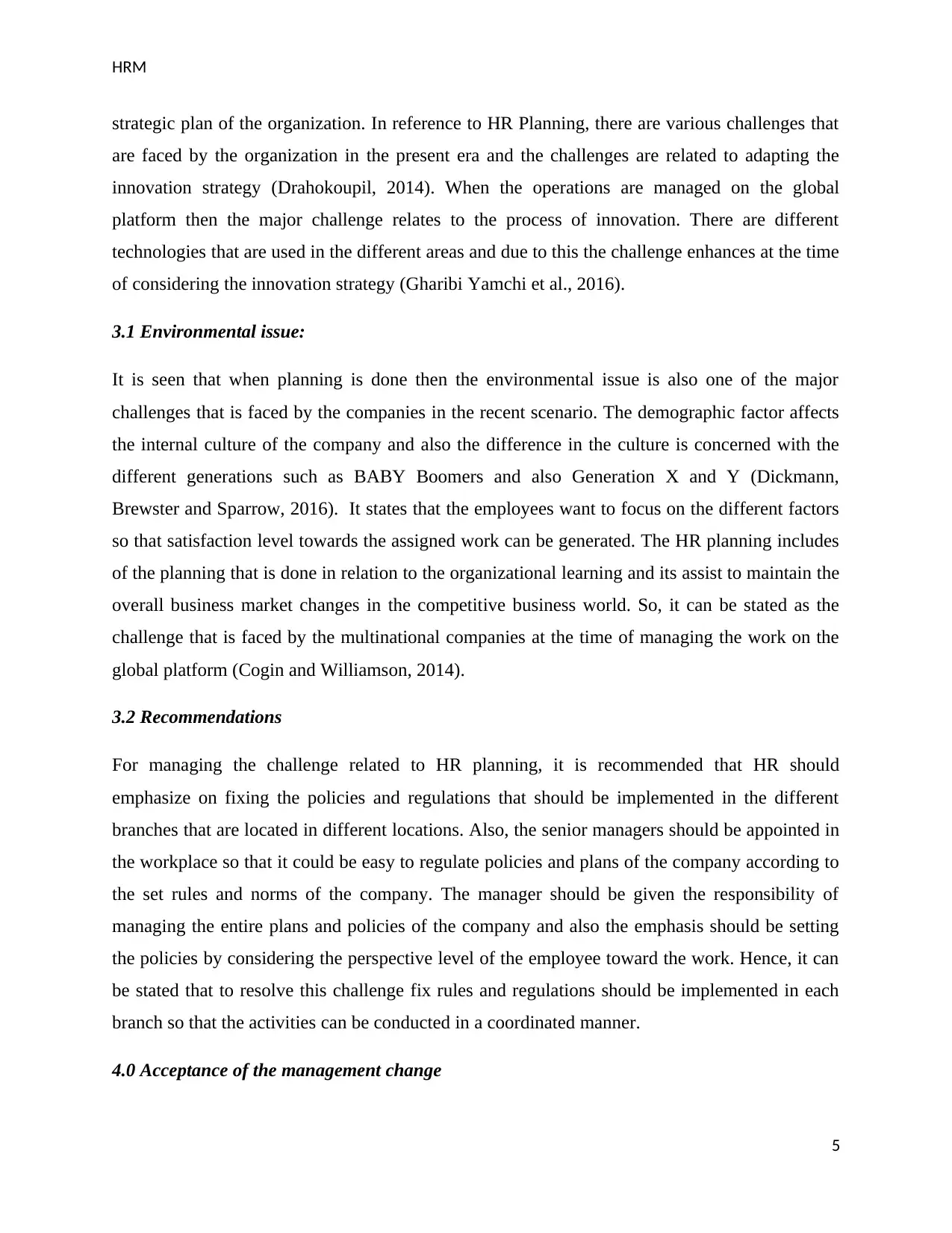
HRM
strategic plan of the organization. In reference to HR Planning, there are various challenges that
are faced by the organization in the present era and the challenges are related to adapting the
innovation strategy (Drahokoupil, 2014). When the operations are managed on the global
platform then the major challenge relates to the process of innovation. There are different
technologies that are used in the different areas and due to this the challenge enhances at the time
of considering the innovation strategy (Gharibi Yamchi et al., 2016).
3.1 Environmental issue:
It is seen that when planning is done then the environmental issue is also one of the major
challenges that is faced by the companies in the recent scenario. The demographic factor affects
the internal culture of the company and also the difference in the culture is concerned with the
different generations such as BABY Boomers and also Generation X and Y (Dickmann,
Brewster and Sparrow, 2016). It states that the employees want to focus on the different factors
so that satisfaction level towards the assigned work can be generated. The HR planning includes
of the planning that is done in relation to the organizational learning and its assist to maintain the
overall business market changes in the competitive business world. So, it can be stated as the
challenge that is faced by the multinational companies at the time of managing the work on the
global platform (Cogin and Williamson, 2014).
3.2 Recommendations
For managing the challenge related to HR planning, it is recommended that HR should
emphasize on fixing the policies and regulations that should be implemented in the different
branches that are located in different locations. Also, the senior managers should be appointed in
the workplace so that it could be easy to regulate policies and plans of the company according to
the set rules and norms of the company. The manager should be given the responsibility of
managing the entire plans and policies of the company and also the emphasis should be setting
the policies by considering the perspective level of the employee toward the work. Hence, it can
be stated that to resolve this challenge fix rules and regulations should be implemented in each
branch so that the activities can be conducted in a coordinated manner.
4.0 Acceptance of the management change
5
strategic plan of the organization. In reference to HR Planning, there are various challenges that
are faced by the organization in the present era and the challenges are related to adapting the
innovation strategy (Drahokoupil, 2014). When the operations are managed on the global
platform then the major challenge relates to the process of innovation. There are different
technologies that are used in the different areas and due to this the challenge enhances at the time
of considering the innovation strategy (Gharibi Yamchi et al., 2016).
3.1 Environmental issue:
It is seen that when planning is done then the environmental issue is also one of the major
challenges that is faced by the companies in the recent scenario. The demographic factor affects
the internal culture of the company and also the difference in the culture is concerned with the
different generations such as BABY Boomers and also Generation X and Y (Dickmann,
Brewster and Sparrow, 2016). It states that the employees want to focus on the different factors
so that satisfaction level towards the assigned work can be generated. The HR planning includes
of the planning that is done in relation to the organizational learning and its assist to maintain the
overall business market changes in the competitive business world. So, it can be stated as the
challenge that is faced by the multinational companies at the time of managing the work on the
global platform (Cogin and Williamson, 2014).
3.2 Recommendations
For managing the challenge related to HR planning, it is recommended that HR should
emphasize on fixing the policies and regulations that should be implemented in the different
branches that are located in different locations. Also, the senior managers should be appointed in
the workplace so that it could be easy to regulate policies and plans of the company according to
the set rules and norms of the company. The manager should be given the responsibility of
managing the entire plans and policies of the company and also the emphasis should be setting
the policies by considering the perspective level of the employee toward the work. Hence, it can
be stated that to resolve this challenge fix rules and regulations should be implemented in each
branch so that the activities can be conducted in a coordinated manner.
4.0 Acceptance of the management change
5
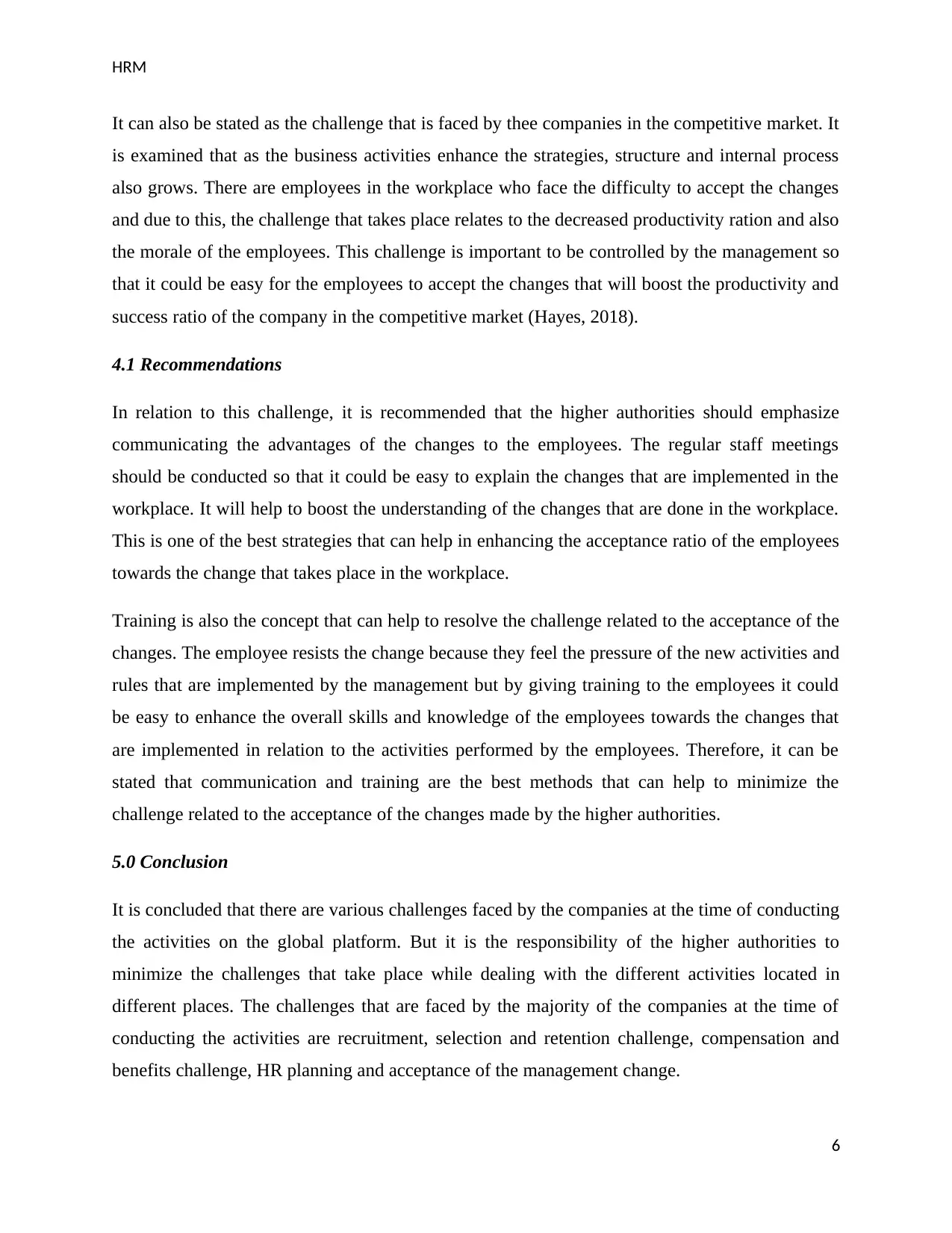
HRM
It can also be stated as the challenge that is faced by thee companies in the competitive market. It
is examined that as the business activities enhance the strategies, structure and internal process
also grows. There are employees in the workplace who face the difficulty to accept the changes
and due to this, the challenge that takes place relates to the decreased productivity ration and also
the morale of the employees. This challenge is important to be controlled by the management so
that it could be easy for the employees to accept the changes that will boost the productivity and
success ratio of the company in the competitive market (Hayes, 2018).
4.1 Recommendations
In relation to this challenge, it is recommended that the higher authorities should emphasize
communicating the advantages of the changes to the employees. The regular staff meetings
should be conducted so that it could be easy to explain the changes that are implemented in the
workplace. It will help to boost the understanding of the changes that are done in the workplace.
This is one of the best strategies that can help in enhancing the acceptance ratio of the employees
towards the change that takes place in the workplace.
Training is also the concept that can help to resolve the challenge related to the acceptance of the
changes. The employee resists the change because they feel the pressure of the new activities and
rules that are implemented by the management but by giving training to the employees it could
be easy to enhance the overall skills and knowledge of the employees towards the changes that
are implemented in relation to the activities performed by the employees. Therefore, it can be
stated that communication and training are the best methods that can help to minimize the
challenge related to the acceptance of the changes made by the higher authorities.
5.0 Conclusion
It is concluded that there are various challenges faced by the companies at the time of conducting
the activities on the global platform. But it is the responsibility of the higher authorities to
minimize the challenges that take place while dealing with the different activities located in
different places. The challenges that are faced by the majority of the companies at the time of
conducting the activities are recruitment, selection and retention challenge, compensation and
benefits challenge, HR planning and acceptance of the management change.
6
It can also be stated as the challenge that is faced by thee companies in the competitive market. It
is examined that as the business activities enhance the strategies, structure and internal process
also grows. There are employees in the workplace who face the difficulty to accept the changes
and due to this, the challenge that takes place relates to the decreased productivity ration and also
the morale of the employees. This challenge is important to be controlled by the management so
that it could be easy for the employees to accept the changes that will boost the productivity and
success ratio of the company in the competitive market (Hayes, 2018).
4.1 Recommendations
In relation to this challenge, it is recommended that the higher authorities should emphasize
communicating the advantages of the changes to the employees. The regular staff meetings
should be conducted so that it could be easy to explain the changes that are implemented in the
workplace. It will help to boost the understanding of the changes that are done in the workplace.
This is one of the best strategies that can help in enhancing the acceptance ratio of the employees
towards the change that takes place in the workplace.
Training is also the concept that can help to resolve the challenge related to the acceptance of the
changes. The employee resists the change because they feel the pressure of the new activities and
rules that are implemented by the management but by giving training to the employees it could
be easy to enhance the overall skills and knowledge of the employees towards the changes that
are implemented in relation to the activities performed by the employees. Therefore, it can be
stated that communication and training are the best methods that can help to minimize the
challenge related to the acceptance of the changes made by the higher authorities.
5.0 Conclusion
It is concluded that there are various challenges faced by the companies at the time of conducting
the activities on the global platform. But it is the responsibility of the higher authorities to
minimize the challenges that take place while dealing with the different activities located in
different places. The challenges that are faced by the majority of the companies at the time of
conducting the activities are recruitment, selection and retention challenge, compensation and
benefits challenge, HR planning and acceptance of the management change.
6
⊘ This is a preview!⊘
Do you want full access?
Subscribe today to unlock all pages.

Trusted by 1+ million students worldwide
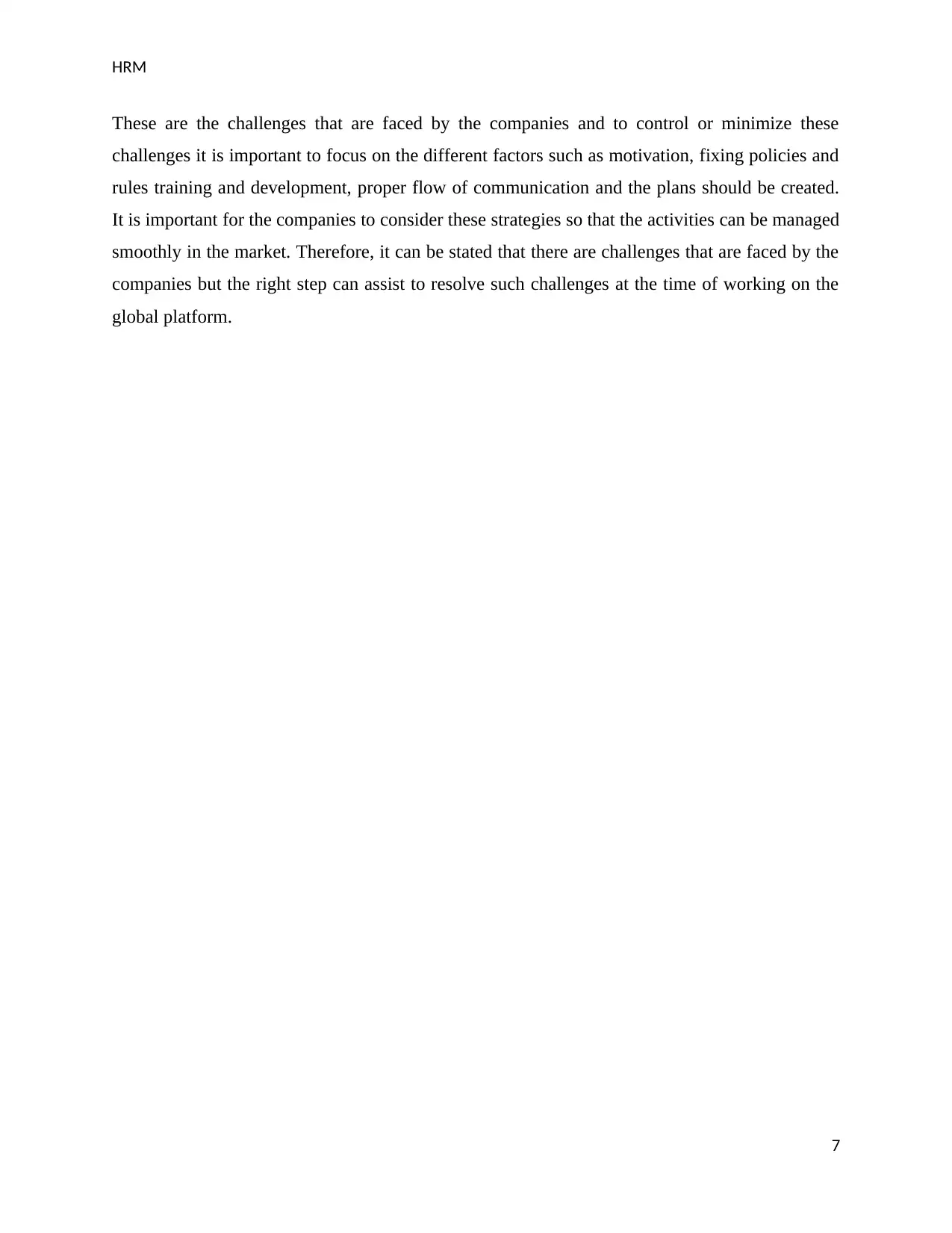
HRM
These are the challenges that are faced by the companies and to control or minimize these
challenges it is important to focus on the different factors such as motivation, fixing policies and
rules training and development, proper flow of communication and the plans should be created.
It is important for the companies to consider these strategies so that the activities can be managed
smoothly in the market. Therefore, it can be stated that there are challenges that are faced by the
companies but the right step can assist to resolve such challenges at the time of working on the
global platform.
7
These are the challenges that are faced by the companies and to control or minimize these
challenges it is important to focus on the different factors such as motivation, fixing policies and
rules training and development, proper flow of communication and the plans should be created.
It is important for the companies to consider these strategies so that the activities can be managed
smoothly in the market. Therefore, it can be stated that there are challenges that are faced by the
companies but the right step can assist to resolve such challenges at the time of working on the
global platform.
7
Paraphrase This Document
Need a fresh take? Get an instant paraphrase of this document with our AI Paraphraser
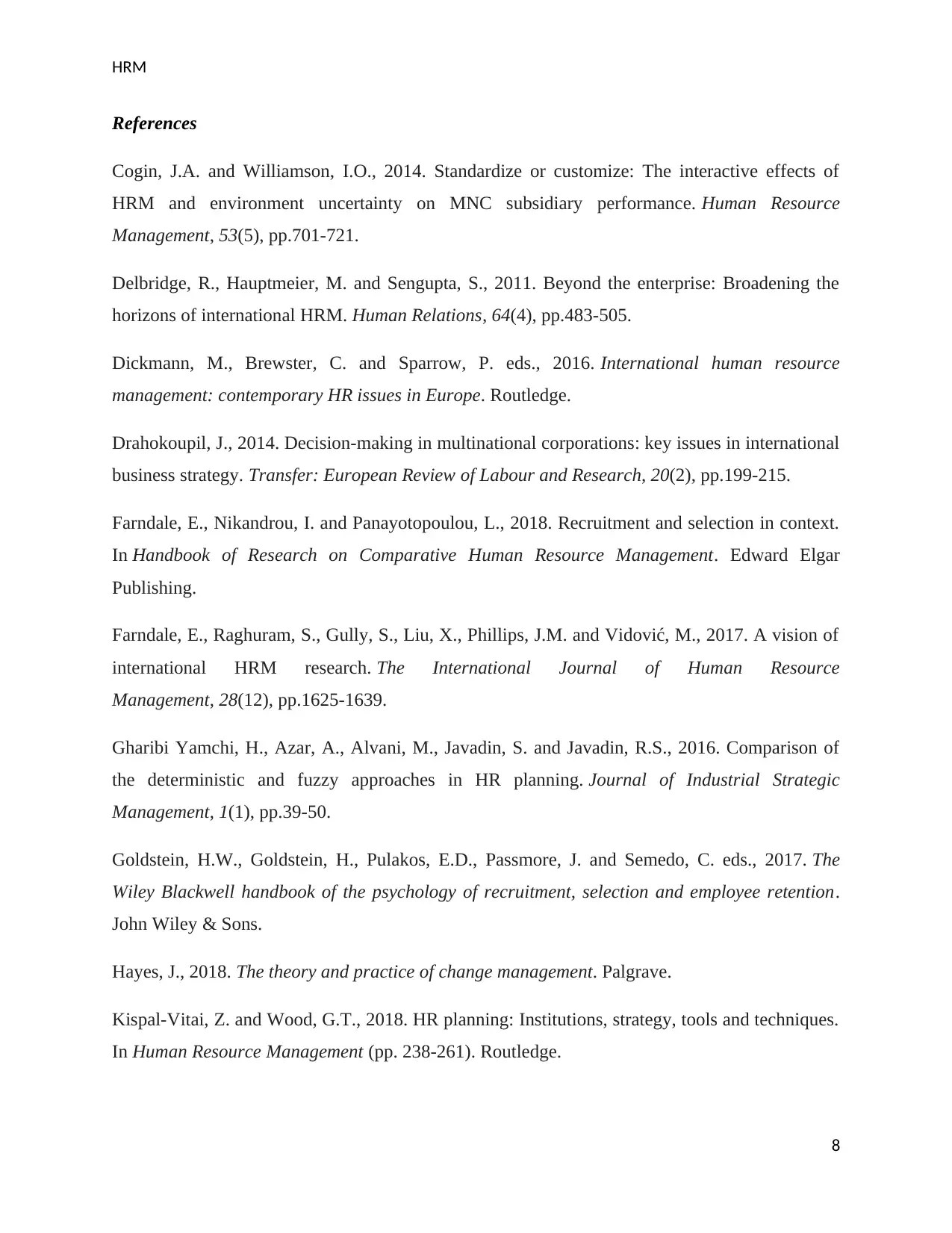
HRM
References
Cogin, J.A. and Williamson, I.O., 2014. Standardize or customize: The interactive effects of
HRM and environment uncertainty on MNC subsidiary performance. Human Resource
Management, 53(5), pp.701-721.
Delbridge, R., Hauptmeier, M. and Sengupta, S., 2011. Beyond the enterprise: Broadening the
horizons of international HRM. Human Relations, 64(4), pp.483-505.
Dickmann, M., Brewster, C. and Sparrow, P. eds., 2016. International human resource
management: contemporary HR issues in Europe. Routledge.
Drahokoupil, J., 2014. Decision-making in multinational corporations: key issues in international
business strategy. Transfer: European Review of Labour and Research, 20(2), pp.199-215.
Farndale, E., Nikandrou, I. and Panayotopoulou, L., 2018. Recruitment and selection in context.
In Handbook of Research on Comparative Human Resource Management. Edward Elgar
Publishing.
Farndale, E., Raghuram, S., Gully, S., Liu, X., Phillips, J.M. and Vidović, M., 2017. A vision of
international HRM research. The International Journal of Human Resource
Management, 28(12), pp.1625-1639.
Gharibi Yamchi, H., Azar, A., Alvani, M., Javadin, S. and Javadin, R.S., 2016. Comparison of
the deterministic and fuzzy approaches in HR planning. Journal of Industrial Strategic
Management, 1(1), pp.39-50.
Goldstein, H.W., Goldstein, H., Pulakos, E.D., Passmore, J. and Semedo, C. eds., 2017. The
Wiley Blackwell handbook of the psychology of recruitment, selection and employee retention.
John Wiley & Sons.
Hayes, J., 2018. The theory and practice of change management. Palgrave.
Kispal-Vitai, Z. and Wood, G.T., 2018. HR planning: Institutions, strategy, tools and techniques.
In Human Resource Management (pp. 238-261). Routledge.
8
References
Cogin, J.A. and Williamson, I.O., 2014. Standardize or customize: The interactive effects of
HRM and environment uncertainty on MNC subsidiary performance. Human Resource
Management, 53(5), pp.701-721.
Delbridge, R., Hauptmeier, M. and Sengupta, S., 2011. Beyond the enterprise: Broadening the
horizons of international HRM. Human Relations, 64(4), pp.483-505.
Dickmann, M., Brewster, C. and Sparrow, P. eds., 2016. International human resource
management: contemporary HR issues in Europe. Routledge.
Drahokoupil, J., 2014. Decision-making in multinational corporations: key issues in international
business strategy. Transfer: European Review of Labour and Research, 20(2), pp.199-215.
Farndale, E., Nikandrou, I. and Panayotopoulou, L., 2018. Recruitment and selection in context.
In Handbook of Research on Comparative Human Resource Management. Edward Elgar
Publishing.
Farndale, E., Raghuram, S., Gully, S., Liu, X., Phillips, J.M. and Vidović, M., 2017. A vision of
international HRM research. The International Journal of Human Resource
Management, 28(12), pp.1625-1639.
Gharibi Yamchi, H., Azar, A., Alvani, M., Javadin, S. and Javadin, R.S., 2016. Comparison of
the deterministic and fuzzy approaches in HR planning. Journal of Industrial Strategic
Management, 1(1), pp.39-50.
Goldstein, H.W., Goldstein, H., Pulakos, E.D., Passmore, J. and Semedo, C. eds., 2017. The
Wiley Blackwell handbook of the psychology of recruitment, selection and employee retention.
John Wiley & Sons.
Hayes, J., 2018. The theory and practice of change management. Palgrave.
Kispal-Vitai, Z. and Wood, G.T., 2018. HR planning: Institutions, strategy, tools and techniques.
In Human Resource Management (pp. 238-261). Routledge.
8
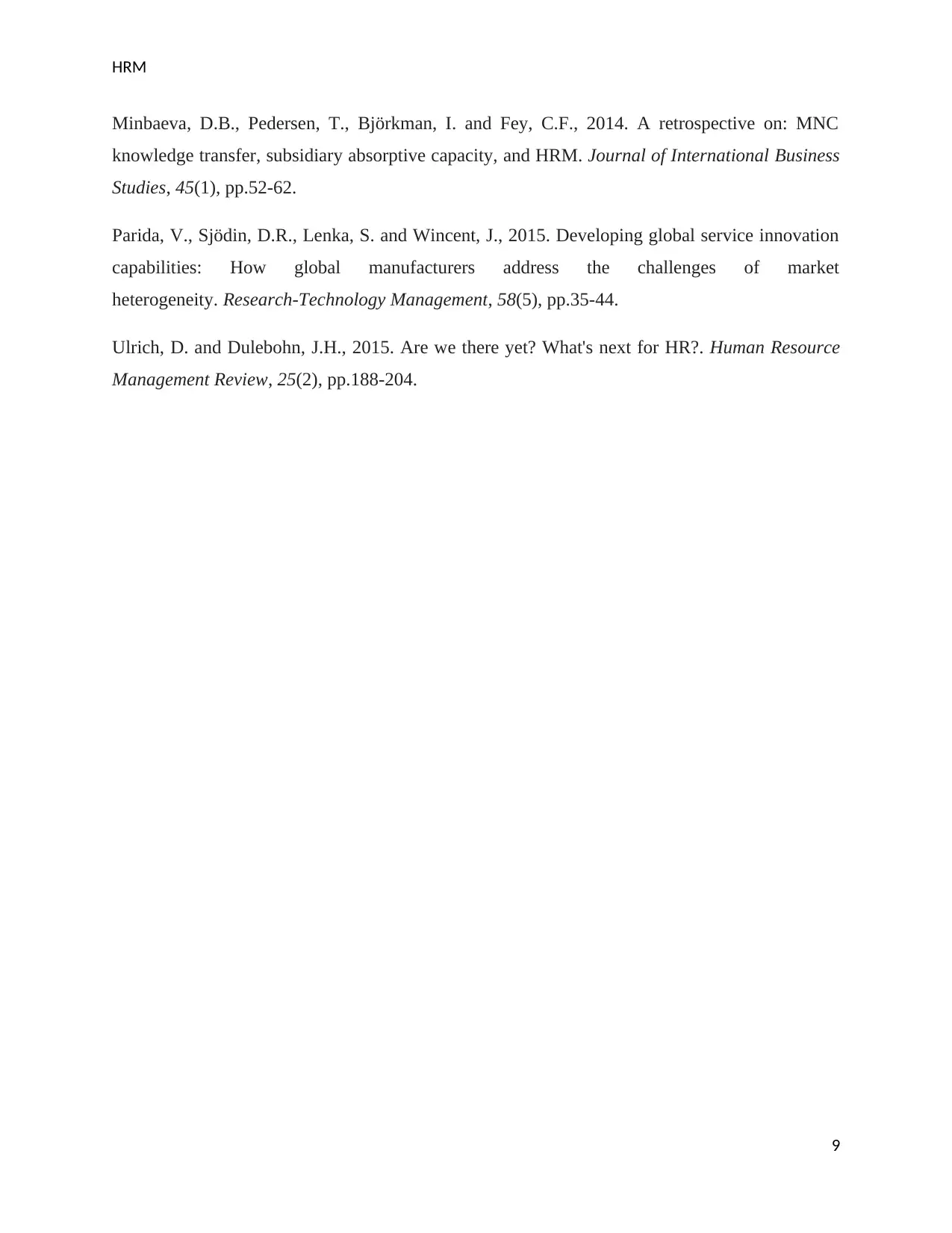
HRM
Minbaeva, D.B., Pedersen, T., Björkman, I. and Fey, C.F., 2014. A retrospective on: MNC
knowledge transfer, subsidiary absorptive capacity, and HRM. Journal of International Business
Studies, 45(1), pp.52-62.
Parida, V., Sjödin, D.R., Lenka, S. and Wincent, J., 2015. Developing global service innovation
capabilities: How global manufacturers address the challenges of market
heterogeneity. Research-Technology Management, 58(5), pp.35-44.
Ulrich, D. and Dulebohn, J.H., 2015. Are we there yet? What's next for HR?. Human Resource
Management Review, 25(2), pp.188-204.
9
Minbaeva, D.B., Pedersen, T., Björkman, I. and Fey, C.F., 2014. A retrospective on: MNC
knowledge transfer, subsidiary absorptive capacity, and HRM. Journal of International Business
Studies, 45(1), pp.52-62.
Parida, V., Sjödin, D.R., Lenka, S. and Wincent, J., 2015. Developing global service innovation
capabilities: How global manufacturers address the challenges of market
heterogeneity. Research-Technology Management, 58(5), pp.35-44.
Ulrich, D. and Dulebohn, J.H., 2015. Are we there yet? What's next for HR?. Human Resource
Management Review, 25(2), pp.188-204.
9
⊘ This is a preview!⊘
Do you want full access?
Subscribe today to unlock all pages.

Trusted by 1+ million students worldwide
1 out of 9
Related Documents
Your All-in-One AI-Powered Toolkit for Academic Success.
+13062052269
info@desklib.com
Available 24*7 on WhatsApp / Email
![[object Object]](/_next/static/media/star-bottom.7253800d.svg)
Unlock your academic potential
Copyright © 2020–2025 A2Z Services. All Rights Reserved. Developed and managed by ZUCOL.





